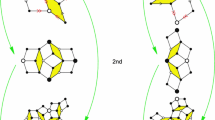Abstract
The discovery of quasicrystals played a revolutionary role in the condensed matter science and forced to renounce the dogma of the classical crystallography that the regular filling of the space by identical blocks is reduced solely to the Fedorov space groups. It is shown that aperiodic crystals, apart from the similarity, exhibit the self-inversion property. In a broadened sense, the self-inversion implies the possible composition of the inversion with translations, rotations, and homothety, whereas pure reflection by itself in a circle can be absent as an independent symmetry element. It is demonstrated that the symmetry of aperiodic tilings is described by Schottky groups (which belong to a particular type of Kleinian groups generated by the linear fractional Möbius transformations); in the theory of aperiodic crystals, the Schottky groups play the same role that the Fedorov groups play in the theory of crystal lattices. The local matching rules for the Penrose fractal tiling are derived, the problem of choice of the fundamental region of the group of motions of a quasicrystal is discussed, and the relation between the symmetry of aperiodic tilings and the symmetry of constructive fractals is analyzed.
Similar content being viewed by others
References
V. Ya. Shevchenko, G. V. Zhizhin, and A. L. Mackay, Russ. Chem. Bull. 62(2), 265 (2013).
W. Steurer and S. Deloudi, Crystallography of Quasicrystals: Concepts, Methods, and Structures (SpringerVerlag, Berlin, 2009).
R. Lifshitz, Isr. J. Chem. 51(11-12), 1156 (2011).
I. Hargittai, J. Mol. Struct. 976, 81 (2010).
Yu. Kh. Vekilov and M. A. Chernikov, Phys.-Usp. 53(6), 537 (2010).
A. E. Madison, Phys. Solid State 55(4), 855 (2013).
N. G. de Bruijn, Proc. K. Ned. Akad. Wet., Ser. A: Math. Sci. 84, 39 (1981).
L. S. Levitov, Sov. Phys. JETP 66(5), 1046 (1987).
M. Senechal, Quasicrystals and Geometry (Cambridge University Press, Cambridge, 1995).
C. Bandt and P. Gummelt, Aequationes Math. 53, 295 (1997).
B. B. Mandelbrot, The Fractal Geometry of Nature (W. H. Freeman, San Francisco, United States, 1982; Institute of Computer Sciences, Moscow, 2002).
F. Gähler, J. Non-Cryst. Solids 153-154, 160 (1993).
H.-Ch. Jeong and P. J. Steinhardt, Phys. Rev. B: Condens. Matter 55(6), 3520 (1997).
E. A. Lord and S. Ranganathan, Acta Crystallogr., Sect. A: Found. Crystallogr. 57, 531 (2001).
P. Gummelt, Geom. Dedicata 62(1), 1 (1996).
H. S. M. Coxeter, Introduction to Geometry (Wiley, New York, 1961; Nauka, Moscow, 1966).
D. Mumford, C. Series, and D. Wright, Indra’s Pearls: The Vision of Felix Klein (Cambridge University Press, Cambridge, 2002).
Le Tu Quoc Thang, S. A. Piunikhin, and V. A. Sadov, Usp. Mat. Nauk 48(1), 41 (1993).
C. Goodman-Strauss, Ann. Math. 147(1), 181 (1998).
J. E. S. Socolar and J. M. Taylor, Math. Intell. 34(1), 18 (2012).
Author information
Authors and Affiliations
Corresponding author
Additional information
Original Russian Text © A.E. Madison, 2014, published in Fizika Tverdogo Tela, 2014, Vol. 56, No. 8, pp. 1651–1661.
Rights and permissions
About this article
Cite this article
Madison, A.E. Self-similarity and self-inversion of quasicrystals. Phys. Solid State 56, 1706–1716 (2014). https://doi.org/10.1134/S1063783414080162
Received:
Accepted:
Published:
Issue Date:
DOI: https://doi.org/10.1134/S1063783414080162



